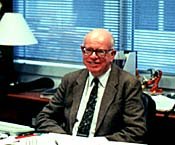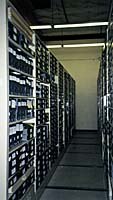Katie Mason profiles the Walt Disney Archives and Animation Research Library
Walt's business card. Maquette models from Beauty and the Beast. A Mickey Mouse children's book in Bulgarian. Background art from 101 Dalmatians. Boxes of memos from Roy Disney. These are a few of the treasures of Disney history which the company has saved in The Archives and The Animation Research Library. The Walt Disney Archives was created in 1970 and is a collection of books, periodicals, corporate correspondence, and other items from the history of the company. Founder Dave Smith states the purpose of the archive is "to collect and preserve all the history of Disney and make it available to the people who need it. It is primarily for company use but serious students and writers doing research on Disney subjects can make an appointment to use the collection as well." The Animation Research Library emerged from the Animation Department's morgue in the late 1980s. It houses art from all of Disney's 36 animated features and numerous short subjects. It caters to artists in Disney's Feature Animation division and is not open to the public.
An Interview with Dave Smith of The Disney Archives

Katie Mason: You founded the Archives in 1970. What moved you to do this? Dave Smith: I had been working as a librarian at UCLA for five years, and I'd done a little work with Disney. On my own, I'd prepared a Disney bibliography, listing Disney films, television shows, books and things like that. I got to know people at the Disney Company while I was doing that. When they decided to do something about preserving their own history, I was in the right place at the right time. I wrote a proposal for them, saying they might want to set up an archive and they hired me to come and do it. We started from an empty office, but we've got a lot of stuff today. KM: What was the company's interest in creating an archive? DS: We were starting to lose some key old-timers here in this company. Walt Disney died in 1966, Roy Disney died in 1971, and up until that time if you'd had a question about the early days of the company, you could go and talk to the person that worked on Snow White or Steamboat Willie for example.
If you think of all the companies in this country, not many others reuse their past as much as Disney does. So many things that Disney did years and years ago are still important in the company's projects today. A good example is Snow White and the Seven Dwarfs, a film we made back in 1937. We put it on video cassette and I think it's the second largest selling video cassette ever.

But, of course, we can use that film in so many other ways. We can do books, records, educational materials, computer software, an attraction at Disneyland, run it on the Disney Channel, put an illustration on our Disney cruise ship. There's so many new different ways we can use these projects than we did so many years ago. When you're delving into your company's past so much, you need a department that's put together the information that you need to have access to--that's why the archives were set up. KM: How do you go about preserving animation history when so much is being done on computers? DS: The question that we're asking [here at the Archives] is how are we preserving the business correspondence of executives when they're doing it on e-mail. You learn so much about a company through the correspondence of its executives. If they're doing a lot of their work on e-mail or over the telephone, which seems to be a lot more common today, it's going to be a lot harder to document. When people come along 20 years from now [it will be harder] to know what was going on in 1998. KM: Do they have all of Walt's correspondence? DS: We have all of that. That was, thank goodness, maintained by his secretaries and it's well arranged by year and then alphabetical by each year. It must be a couple hundred boxes of correspondence. We have Roy Disney's correspondence too and various correspondence of other executive officers of the company through the years. I'm sure some day we'll get Michael Eisner's correspondence.
A Discussion with Lella Smith, Doug Engalla, and Vivian Procopio of the Animation Research Library (ARL) KM: Why did the Animation Research Library start?

Lella Smith: The company was looking for a vehicle whereby any division of Disney could come in and get images for their projects whether it be Art Classics, Walt Disney Imagineering, or Disney Cruise Lines. They come to the ARL and that image can be provided to them as reference.
It is easily the largest animation library in the world and a pretty valuable asset to the company. Not only because of its value, but because [the material is] used and re-used.
Vivian Procopio: Mainly, the artwork here is geared to help the upcoming artist to learn how animation was done in the past and for inspiration and ideas. Other projects include the books that are published on animation. [Authors] usually come here for reference to put in their books. Doug Engalla: Walt Disney Art Classics tend to turn to the animation art to stay as faithful to the original as possible. It's such a sophisticated audience out there, they will still step through a video and look and see how close it is. It's a very savvy audience. LS: Plus, the Disney company likes the product to be on-model. It's our hope that they will come to us and get the actual image and the result will really look like Mulan.
VP: As precise to the character--design, color, and all the different elements--as possible. LS: Even TV animation, if they have a spin-off, wants to make certain that the characters are true to the original film, so they come here. KM: So an animator could go back and study exactly how the prince kissed Snow White and model their newer animation on that?

LS: Yes. It's here for the animators to use. We're actually under Feature Animation so we have a real love and dedication to them. They'll come here and they'll flip drawings. It's really interesting to watch because even artists who feel that they are really, really advanced in animation will come and look at a Milt Kahl or a Marc Davis and say, "Whoa. I gotta go practice drawing again." DE: Recently, we had background and layout artists from a current project look at art from Lady and the Tramp. Subject-wise it doesn't look like it relates at all to what they're doing, but technique-wise it was very helpful for them. LS: One thing they were trying to do was evening scenes, which are really hard to do, so Doug pulled several of the night scenes. KM: How is the art preserved? LS: We had a whole line of materials developed for animation. There are all kinds of archival companies that focus on supplies for museum collections, but we had very different needs, different sizes. We found a polyethylene that goes between the layers of the cels so that the paint doesn't stick. We have a sleeve that we can slip the paper backgrounds into because the backgrounds are often just a long piece of paper and if you touch them you can not only get oil on them but it damages the paper. We also developed a cel mat holder that would allow the weight to be around the edges of the cardboard folder so that you could hold it and not press the cels on top of each other. There's a lot more known about the damage of rubber bands and paper clips and staples and we're doing our damnedest to get all that out. So we've been working hard to find ways to protect the art better. KM: How do you go about preserving animation art in an era of digital ink and paint and computer animation?

LS: We are getting more of the collection digitally and that's a challenge for us because we have to continue to learn as we go. But we're able to work very closely with CAPS [Computer Animation and Production System which unites Scene Planning, Scanning, Color Model, Ink and Paint, and Compositing]. Some of the images may simply be stored on-line and we'll pull from those. Now we can look into the Fame system, which tells where everything is moving and how many layers were on top of a background. It's not as straightforward as it was before because you'd go and pull a cel and put in over a background and you'd have a cel set-up. But we're working very closely with the technology division. Since the color is created on the computer, we find ourselves working more with the computer folks.
DE: Luckily though, we're still very traditionally-based as far as animation is concerned. There will always be a desire, even in the digital age, to see the foundation. Even if currently we're unable to provide a color image for somebody on the outside, we still have character designs and pre-production art that is very important to any feature project. LS: But the exciting thing for us is we're trying to keep up with technology. Technology is not necessarily a bad thing for us. Where previously we were only able to provide a color copy, now we can scan the art and give a digital file in any format people need so they can go right to press, and that's a good thing. Researchers can make an appointment at the Disney Archives only by calling (818) 560-5424. Katie Mason was an editorial assistant at Animation World Magazine. A longtime animation reader and fan, she watches cartoons each Saturday morning and is currently studying toward her university degree.








